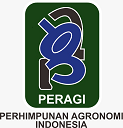Deteksi Fusarium Patogenik Terbawa Umbi Benih Beberapa Varietas Bawang Merah (Allium cepa L. group aggregatum)
Abstract
Infeksi patogen tanaman merupakan salah satu penyebab menurunnya produksi bawang merah di Indonesia. Salah satu penyakit utama pada bawang merah adalah busuk pangkal batang yang disebabkan oleh infeksi Fusarium oxysporum. Infeksi Fusarium patogenik pada umbi benih bawang merah dapat menyebabkan kejadian penyakit busuk pangkal batang pada tanaman bawang merah. Oleh karena itu perlu dilakukan uji kesehatan umbi benih, untuk mendeteksi keberadaan Fusarium patogenik pada umbi benih bawang merah. Uji kesehatan umbi benih bawang merah dilakukan dengan menggunakan metode blotter test. Selanjutnya isolat Fusarium yang muncul dari hasil blotter test diuji sifat patogenisitasnya pada umbi dan tanaman bawang merah. Penelitian ini bertujuan untuk mendeteksi keberadaan Fusarium terbawa umbi benih bawang merah pada beberapa varietas dan sifat patogenisitasnya. Hasil penelitian menunjukkan varietas bawang merah dengan persen infeksi Fusarium tertinggi pada varietas Bima (74,5%) dengan nekrosis basal plate (79%). Hasil uji patogenisitas menunjukkan dari 60 isolat Fusarium diperoleh dari uji blotter test, 46,6% merupakan isolat Fusarium patogenik.
Keywords
Full Text:
PDFReferences
Aprilia, I., Maharijaya, A., & Wiyono, S. (2020). Genetic Diversity and Fusarium Wilt Disease Resistance (Fusarium oxysporum f.sp cepae) of Indonesian Shallots (Allium cepa L. var aggregatum). Jurnal Hortikultura Indonesia, 11(1), 32–40. https://doi.org/10.29244/jhi.11.1.32-40
Asrul, A.-, Rosmini, R., Rista, A., Astuti, I. D., & Yulianto, A. (2021). Karakterisasi Jamur Penyebab Penyakit Busuk Pangkal Batang (Basal Rot) pada Bawang Wakegi (Allium x wakegi Araki). Agro Bali : Agricultural Journal, 4(3), 341–350. https://doi.org/10.37637/ab.v4i3.835
Bektaş, I., Küsek, M., Bektas, I., & Kusek, M. (n.d.). PHYLOGENETIC AND MORPHOLOGICAL CHARACTERIZATION OF FUSARIUM OXYSPORUM F. SP. CEPAE THE CAUSAL AGENT OF BASAL ROT ON ONION ISOLATED FROM TURKEY. https://www.researchgate.net/publication/332633592
Cramer, C. S., Mandal, S., Sharma, S., Nourbakhsh, S. S., Goldman, I., & Guzman, I. (2021). Recent advances in onion genetic improvement. Agronomy, 11(3). https://doi.org/10.3390/agronomy11030482
Dabire, T. G., Neya, B. F., Somda, I., & Legreve, A. (2021). Pathogenicity study of some seed-borne fungi of onion (Allium cepa L.) from Burkina Faso. International Journal of Biological and Chemical Sciences, 15(3), 1062–1072. https://doi.org/10.4314/ijbcs.v15i3.17
Havey, M.J. (2008). Fusarium basal rot. Di dalam: Howard FS, Mohan SK, editor. Compendium of onion and garlic diseases and pests. 2nd ed. Minnesota (US). APS Press. hlm 12-14
Herlina, L., Istiaji, B., & Wiyono, S. (2021). The Causal Agent of Fusarium Disease Infested Shallots in Java Islands of Indonesia. E3S Web of Conferences, 232. https://doi.org/10.1051/e3sconf/202123203003
ISTA. (2011), ISTA rules, International Seed Testing Association, Bassersdorf, Swizerland.
Kalman, B., Abraham, D., Graph, S., Perl-Treves, R., Harel, Y. M., & Degani, O. (2020). Isolation and identification of fusarium spp., the causal agents of onion (allium cepa) basal rot in northeastern israel. Biology, 9(4). https://doi.org/10.3390/biology9040069
Kondo, N., Kobayashi, K., & Ogoshi, A. (n.d.). Vegetative Compatibility Groups within Fusarium oxysporum f. sp. cepae in Hokkaido-Japan.
Le, D., Audenaert, K., & Haesaert, G. (2021). Fusarium basal rot: profile of an increasingly important disease in Allium spp. In Tropical Plant Pathology (Vol. 46, Issue 3, pp. 241–253). Springer Science and Business Media Deutschland GmbH. https://doi.org/10.1007/s40858-021-00421-9
Leslie, J. F., Summerell, B. A., & Bullock, S. (2006). The Fusarium Laboratory Manual.
Pawar, D. S., & Nasreen, S. (2007). Isolation and Identification of Some Pathogenic Fungi from Different Infected Vegetables. International Journal of Innovative Research in Science, Engineering and Technology (An ISO, 3297. https://doi.org/10.15680/IJIRSET.2016.0503032
Perubahan Curah Hujan terhadap Produktivitas Tanaman Bawang Merah, S., Riyadlus Sholikin, A., & Didik Haryono, dan. (2019). The Study of Rainfall Changes to Shallot Productivity (Allium ascalonicum L.) in Several Production Centers. Jurnal Produksi Tanaman, 7(9), 1587–1594.
Prakoso, K. I. (2021). Affecting Factors of Shallots Production Level in Wanasari Sub-District Brebes Regency. Business and Economic Analysis Journal, 1(1), 27–37. https://doi.org/10.15294/beaj.v1i1.30143
Roncero, M. I. G., Hera, C., Ruiz-Rubio, M., García Maceira, F. I., Madrid, M. P., Caracuel, Z., Calero, F., Delgado-Jarana, J., Roldán-Rodríguez, R., Martínez-Rocha, A. L., Velasco, C., Roa, J., Martín-Urdiroz, M., Córdoba, D., & Di Pietro, A. (2003). Fusarium as a model for studying virulence in soilborne plant pathogens. In Physiological and Molecular Plant Pathology (Vol. 62, Issue 2, pp. 87–98). Academic Press. https://doi.org/10.1016/S0885-5765(03)00043-2
Saputri, A. S., Tondok, E. T., & Hidayat, S. H. (2019). Insidensi Virus dan Cendawan pada Biji dan Umbi Bawang Merah. Jurnal Fitopatologi Indonesia, 14(6), 222. https://doi.org/10.14692/jfi.14.6.222
Shamyuktha, J., Sheela, J., Rajinimala, N., Jeberlinprabina, B. M., & Ravindran, C. (2020). Survey on Onion Basal Rot Disease Incidence and Evaluation of Aggregatum Onion (Allium cepa L. Var. Aggregatum Don.) Genotypes Against Fusarium oxysporum f. sp. Cepae. International Journal of Current Microbiology and Applied Sciences, 9(7), 529–536. https://doi.org/10.20546/ijcmas.2020.907.058
Southwood, M. J., Viljoen, A., & McLeod, A. (2015). Inoculum sources of Fusarium oxysporum f.sp. cepae on onion in the Western Cape Province of South Africa. Crop Protection, 75, 88–95. https://doi.org/10.1016/j.cropro.2015.05.014
Surahman, dan, Besar PPMB-TPH, B., Pertanian, K., Raya Tapos Kotak Pos, J., & Barat, J. (2014). Pengembangan Teknik Deteksi Fusarium Patogen Pada Umbi Benih Bawang Merah (Allium ascalonicum) di Laboratorium [Development of Detection Technique for Fusarium Pathogen on Seedling Shallot (Allium ascalonicum) Bulb at Laboratorium]. In J. Hort (Vol. 24, Issue 2).
Taylor, A., Teakle, G. R., Walley, P. G., Finch-Savage, W. E., Jackson, A. C., Jones, J. E., Hand, P., Thomas, B., Havey, M. J., Pink, D. A. C., & Clarkson, J. P. (2019). Assembly and characterisation of a unique onion diversity set identifies resistance to Fusarium basal rot and improved seedling vigour. Theoretical and Applied Genetics, 132(12), 3245–3264. https://doi.org/10.1007/s00122-019-03422-0
Triwidodo, H., & Tanjung, M. H. (2020). Hama Penyakit Utama Tanaman Bawang Merah (Allium Ascalonicum) dan Tindakan Pengendalian di Brebes, Jawa Tengah. Agrovigor: Jurnal Agroekoteknologi, 13(2), 149–154. https://doi.org/10.21107/agrovigor.v13i2.7131
Widono, S., Hadiwiyono, Poromarto, S. H., Supyani, & Wahyuni, N. (2022). Sensitivity of bulb tissue section for detection of Fusarium causes Moler disease of shallot. IOP Conference Series: Earth and Environmental Science, 1018(1). https://doi.org/10.1088/1755-1315/1018/1/012003
Refbacks
- There are currently no refbacks.



























